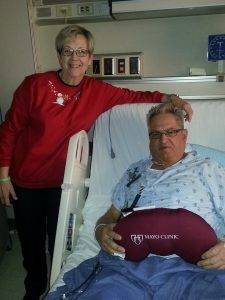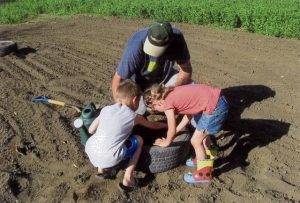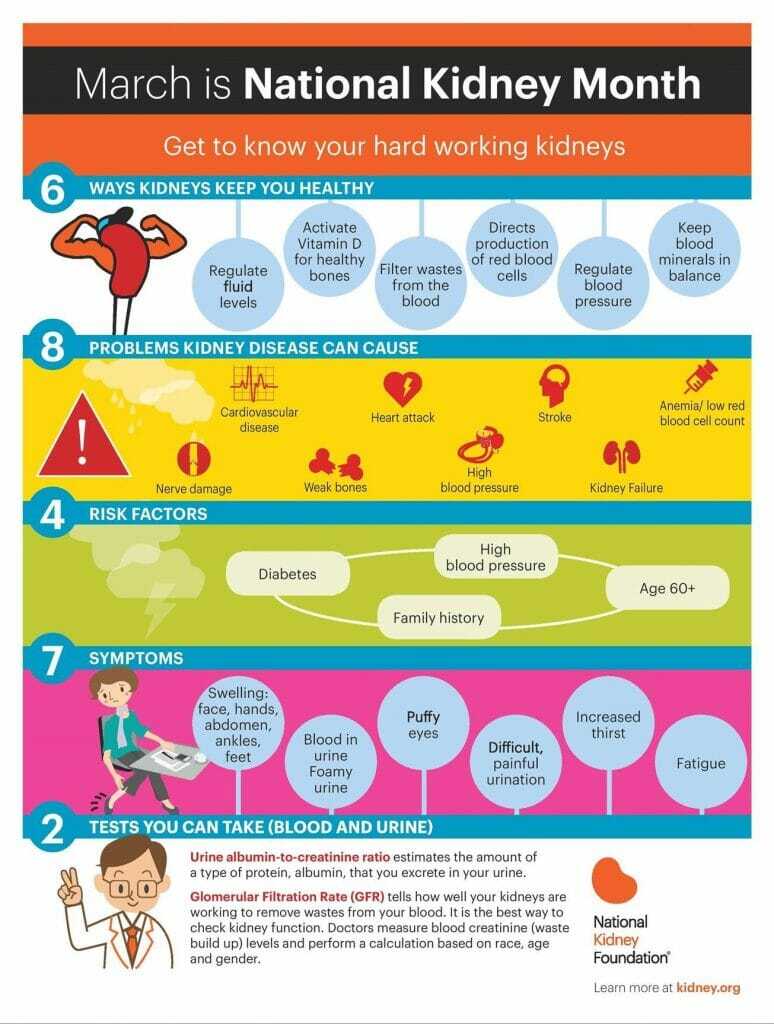
Shirley and Jim Fesenmeyer in Mayo Clinic after Jim’s kidney transplant on Feb. 26, 2014.
How far would you go to save someone’s life?
My mom saved the life of someone whom she had before never met. A stranger saved my dad’s life.
Five years ago on Feb. 26 – which also was my daughter’s milestone 13th birthday – my family and I gathered in the waiting room at Mayo Clinic in Rochester as my dad was wheeled into surgery. In an adjacent room, a selfless woman went into surgery to remove one of her kidneys for my dad.
This day was years in the making.
My dad, Jim Fesenmeyer of Greene, Iowa, was 28 years old when he was diagnosed with kidney disease. His situation was monitored every six months for 42 years. His health started to decline in 2000, but his local kidney doctor insisted all was well. My parents decided it was time for a second opinion.
They traveled to a prominent Iowa hospital where a doctor told my dad that he had less than 50% kidney function. My parents were shocked and asked what could be done. The doctor then shockingly replied, “Mr. Fesenmeyer, we all have to die some time.”
Not ones to just give up, my parents took matters into their own hands. They were determined to get an appointment at Mayo Clinic, but that’s easier said that done. At that time, Mayo was only accepting new patients if someone didn’t show up for a scheduled appointment. My parents made the two-hour drive, one way, every day from April until July 2000. Every day for three months they waited from 7 a.m. to noon in hopes of getting an appointment for a diagnosis from the Mayo Clinic.
Finally, on July 3, 2000, my dad finally got an appointment at the Mayo Clinic. He was diagnosed with Polycystic Kidney Disease (PDK), which causes the kidney to fill with polyps. These fluid-filled cysts in the kidneys prevent them from working properly.
A team of specialist put Dad on a specific diet that was more restrictive than the low sodium diet he had been following. He had to more closely monitor the amount of protein and carbohydrates in his diet. This was no small feat for this meat and potatoes lover!

When my kids were about age 5, my dad showed them how to plant and care for watermelons. Homegrown watermelons and tomatoes were among the foods my dad was most eager to eat after his kidney transplant.
Protein is one of your body’s building blocks but eating too much protein can make your kidneys work harder. Carbohydrates are the easiest kind of energy for your body to use, but some carbs are high in potassium and phosphorus. Your body needs some potassium to make your muscles work, but too much potassium can be dangerous. When your kidneys aren’t functioning properly, you must limit your potassium intake. That meant my dad had to give up eating fresh tomatoes and watermelons he enjoyed growing in his garden.
Once Dad was under the supervision of Mayo doctors, his creatinine levels improved. He was placed on a kidney transplant list, but he was told the odds weren’t good that he would receive a cadaver kidney. Another person is added to the national transplant waiting list every 10 minutes, according to the American Kidney Fund. There are nearly 100,000 people on the kidney transplant waiting list. Many people wait for five to 10 years for a kidney from a deceased donor.
Quite frankly, my dad’s age and condition didn’t give him the luxury of waiting for a cadaver kidney. A search began in earnest for a living donor. My dad’s four sisters were tested but none of them could donate. About 20 of my parents’ friends filled out paperwork to get tested as a donor. One of my dad’s close friends was a match. Knowing he had a kidney at the ready gave my dad peace of mind. Two years later when that same friend was tested again, he no longer passed the test.
To say that was a blow to the psyche is a severe understatement. My dad was in despair, but my tenacious mother was determined to make the transplant happen. Mom learned about the paired kidney donor program, and without telling me or my brother, she was tested to become a living donor. Mom’s donation to a stranger allowed my dad to receive a kidney from Mary Baumgart of Minnesota City, Minn. Mary’s donation allowed her friend Sue to receive the kidney she so desperately needed.
Mary and Sue met in Bible Study. When Mary learned Sue needed a kidney, she answered the call.
“Right then I knew in my soul that God had said to me, ‘You’re going to be the one to give the kidney to Sue,’” said Mary in an April 16, 2014, article that ran in the Greene Recorder. “Like it says in 2 Corinthians concerning the church body, ‘When one hurts, all hurt. When one is blessed, all are honored’.”
So many lives have been blessed since the first paired kidney transplant occurred in 2000. About one-third of all kidney transplants performed in the U.S. are living-donor transplants. It takes about three to six months to coordinate a live transplant. If you’re interested in becoming a living donor, visit mayoclinic.org/livingdonor.
The living-donor kidney transplant offers these benefits:
- Less time spent on a waiting list, which could prevent possible complications and deterioration of health.
- Potential avoidance of dialysis. (My dad’s kidney function started dropping rapidly. He was literally one week away from going on dialysis when his kidney match was made.)
- Better short- and long-term survival rates.
- A pre-scheduled transplant once your donor is approved versus an unscheduled, emergency transplant procedure with a deceased donor.
- Living-donor kidneys almost always start working immediately after transplant compared with deceased-donor kidneys that can have delayed function
In celebration of March National Kidney Month, we’re helping spread the word about Polycystic Kidney Disease. We’re also sharing a recipe from Hy-Vee for Fajita-Style New York Strip Steak and Veggies, which has been slightly adapted to dietician-approved and kidney-friendly.
Get more great healthy recipe ideas from https://www.hy-vee.com/recipes-ideas. Click here for a Family Recipe Book for Kidney Patients. Below are links to two past blog articles that include more healthy tips and recipes:

Fajita-Style New York Strip Steak and Veggies
Ingredients
2 (4-oz.) New York strip steaks, 3/4-inch-thick
1 tsp. ground cumin
1 tsp. ground coriander
1 tsp. paprika
1 tsp. ground black pepper
2 tbsp. olive oil, divided
3 cloves garlic, minced
1 white onion, cut into thin wedges
1 c. tricolor julienne bell pepper strips
Fresh jalapeno, sliced, for garnish
Instructions
- Pat steaks dry with paper towels; set aside. Combine cumin, coriander, paprika, and black pepper in a small bowl. Rub seasoning mixture evenly onto steaks; set aside.
- Heat 1 tablespoon oil in a large nonstick skillet over medium-high heat. Cook steaks for 6 minutes for medium-rare (130 degrees), turning once halfway though. Transfer to two serving plates; cover and keep warm.
- Meanwhile, heat remaining 1 tablespoon oil in same skillet over medium heat. Add garlic and cook for 30 seconds. Add onion and bell pepper strips. Cook for 5 to 8 minutes or until crisp-tender, stirring occasionally. Serve steaks; garnish with jalapeno slices, if desired.
The nutritional values are the following: 280 calories, 19.5 Fat, 6 g Saturated Fat, 5.5 g Carbohydrate, 1.5 g Fiber, 320 mg sodium, 22 g Protein, 2% calcium, 3% potassium, 15% iron.
Photo & recipe credit to Hy-Vee at https://www.hy-vee.com/recipes-ideas/recipes/fajita-style-new-york-strip-steak-and-veggies.


